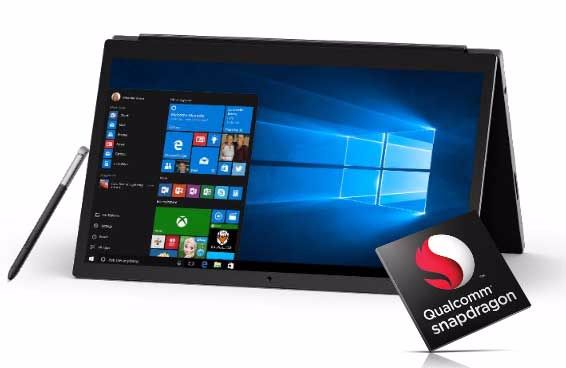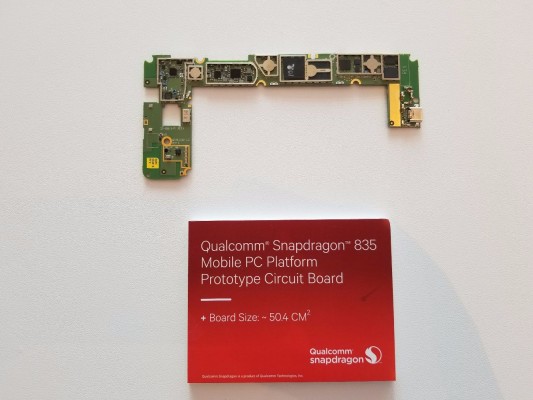Windows 10 Coming to Snapdragon 835-Powered Laptops
Windows 10 — real, full Windows 10 — is coming to a mobile processor. At Computex in Taipei, Microsoft and Qualcomm announced that the popular operating system will run on the Snapdragon 835 CPU. The first confirmed partners to make laptops based on this processor are Lenovo, HP and Asus.
The Snapdragon 835, Qualcomm’s most powerful chip at the moment, is what powers the Samsung Galaxy S8. The company's new goal is to use the chip for slim, long-lasting laptops that are constantly connected to the internet.
Laptops, Qualcomm vice president of product marketing, Don McGuire told me, are too reliant on Wi-Fi, have limited battery life and run too hot. The company’s vision is an “always connected PC,” using Gigabit LTE for constant data, battery life that goes all day and beyond, innovative designs that make use of the extra space left over from the tiny Snapdragon 835 CPU and the full Windows 10 experience with all of its apps.
That last point is a sore one for Qualcomm, as the ARM-based Windows RT, a hobbled version of Windows 8, didn’t support many apps and never had an upgrade path to Windows 10. This time, reps told me, they have it right. In fact, they think they’re making the laptop ecosystem better.
Smartphone Features on PCs
Qualcomm is also bringing some of its smartphone expertise to PCs. The devices will stay connected even when they’re in standby just like a handset. The company is promising truly instant-on functionality, with no wait, just like a smartphone. Data will sync in standby, and Cortana will even be active and listening. The company claims that Snapdragon-powered laptops will last four to five times longer than other laptops in standby.
The 835 is Qualcomm’s first 10 nanometer chip. It’s smaller than a penny, and reps reminded me by showing me both the chip and the one-cent coin. Because it’s so small, manufacturers can get between 20 - 30 percent size savings on a PCB, which leaves room for larger batteries. In general, the company told me that Snapdragon-based machines will have up to 50 percent better battery life than competitors. With its x6 LTE modem as part of the platform, they claim you can get 1 Gbps peak speeds, with sustained speeds for streaming video at 150 - 200 Mbps.
In terms of overall performance, Qualcomm’s director of product management, Monte Giles, said it would be similar to that of an Intel Y-series low-power CPU. While Intel's Y Series processors, which were formerly known as Core m, have a mixed reputation they usually provide speed that's good enough for multitasking, media viewing and light productivity.
Sign up to receive The Snapshot, a free special dispatch from Laptop Mag, in your inbox.
Every single Snapdragon device will come with LTE built in, so you don't need to worry about providing your own. E-Sim technology will allow you to add your data plan in just a few clicks through the Windows Store.
MORE: How to Use Windows 10 - Guide for Beginners & Power Users
Everything You Expect From Windows 10
After seeing a demo, I was fully convinced this is real Windows. Sure, they showed me Office, making pivot tables in Excel, copying that to PowerPoint, grabbing some text from Word and emailing it out via Outlook. That was familiar. But what sealed the deal that this was real Windows is that they downloaded and ran a 32-bit legacy app, 7-Zip, a file manager and archiver, right before my eyes.
They also downloaded video very fast. A 1080p YouTube video transferred at roughly 370 Mbps, and took about 30 seconds to download. That’s fast, though I wasn’t informed of exactly which network they were using here in Taipei, and if that can be extracted to the Verizons and AT&Ts of the world when they join the Gigabit bandwagon.
The chip uses a big.LITTLE architecture — a first for Windows. What that means for you is power savings. Individual cores can “park” or rest when they aren’t needed, saving precious resources, and in turn, battery life.
Ready for VR and AR?
The Snapdragon 835 has some experience in AR and VR. After all, it was part of Google’s reference design for its Daydream standalone headset. Does this mean it will work with Microsoft’s Mixed Reality headsets, like those from Acer and HP? Qualcomm wouldn’t give me any details officially, but said that it would make sense for it to occur given the chip’s history in mobile VR.
We expect to learn even more at Microsoft’s Computex press conference, and will update this story with any pertinent information. We’ll bring you more about this groundbreaking news as we learn it.
Image credit: Qualcomm
Windows 10 Basics
- 7 Settings to Change Right Away
- Windows 10 Keyboard Shortcuts to Save You Clicks
- 5 Ways to Take Screenshots
- Change Your Password in Windows 10
- Uninstall Programs in Windows 10
- Enable or Disable Tablet Mode
- Add a User (Child or Adult)
- Change the Screen Resolution
- Sync Your Settings Across Devices
- Sync iPhone with Windows 10
- Control Windows 10 with Your Voice
- Upgrade to Windows 10 From Windows 7 or 8
- Eliminate Blue Light With Night Light
- Create a New Folder
- Get to the Desktop in Windows 10
- Add a Printer
- All Windows 10 Tips
- Set Alarms
Andrew is a contributing writer at Laptop Mag. His main focus lies in helpful how-to guides and laptop reviews, including Asus, Microsoft Surface, Samsung Chromebook, and Dell. He has also dabbled in peripherals, including webcams and docking stations. His work has also appeared in Tom's Hardware, Tom's Guide, PCMag, Kotaku, and Complex. He fondly remembers his first computer: a Gateway that still lives in a spare room in his parents' home, albeit without an internet connection. When he’s not writing about tech, you can find him playing video games, checking social media and waiting for the next Marvel movie.


